
Chinedu K. Ijomah
Work place: Department of Physics, Federal University of Technology, P.M.B 704, Akure, 2340001, Nigeria
E-mail: ijomahck@yahoo.com
Website:
Research Interests: Engineering
Biography
Chinedu Kayode Ijomah is a graduate student in Communication Physics Option at the Federal University of Technology Akure, Nigeria. His research interests include mobile and satellite communication network, RF propagation studies, machine learning and study of the effects of rain wave on microwave propagation among others.
Author Articles
Artificial Neural Networks for Earth-Space Link Applications: A Prediction Approach and Inter-comparison of Rain-influenced Attenuation Models
By Joseph S. Ojo Chinedu K. Ijomah Shittu B. Akinpelu
DOI: https://doi.org/10.5815/ijisa.2022.05.05, Pub. Date: 8 Oct. 2022
The impact of rain-influenced attenuation (RIA) has a more pronounced effect as frequency increases, especially in the tropical zones with heavier rainfall than the temperate zones. The International Telecommunication Union (ITU) has recommended a universal model which may not fit well in this tropical region due to the temperate data used to develop the model. It is therefore necessary to adopt locally measured data to develop a suitable model for each region, as also recommended by ITU recommendation 618-13. The experimental site for this study is at the Department of Physics, Federal University of Technology, Akure, Nigeria (7.299° N, 5.147° E) in the tropical rainforest region of Nigeria. In the present work, the backpropagation neural network (BPNN) of the artificial neural network (ANN) is trained based on time-series rain rates data collected between 2015 and 2019 to predict time-series RIA. Based on four inputs (rain rate, rain heights, elevation angle, and polarization angle), the generated data was subjected to training, validation, and testing. The ANN was further trained using the Levenberg-Marquardt algorithm to fit the inputs and the targets to create a dynamic model for RIA forecasting. Further validation was tested using actual data of rain attenuation from a Ku-band beacon at the site. Subsequently, the RIA model created by the ANN was compared to those generated using the synthetic storm technique, ITU, and the actual rain attenuation obtained from a beacon measurement. The highest rain rate observed was about 225.8 mm/hr with a corresponding rain attenuation of about 61 dB as estimated by the SST model and about 68 dB by the ITU model, while the predicted attenuation by the ANN is 55 dB. This implies that an extra power of 6 dB and 13 dB is added by the SST model and ITU model, respectively, for the downlink signal, to compensate for the rain attenuation link. The results also reveal that during 0.01 percent of an average year that signal may be attenuated, a relatively tiny margin of error between anticipated rain attenuation using ANN and the SST model is exceeded. In general, the new ANN-generated RIA model had the lowest root mean square error, average relative error, and standard deviation at the selected time percentages, according to the model validation. Hence, the new ANN model can predict more effective RIA in the region when compared with the global ITU-R model.
[...] Read more.Other Articles
Subscribe to receive issue release notifications and newsletters from MECS Press journals